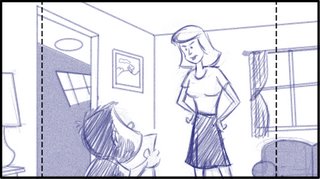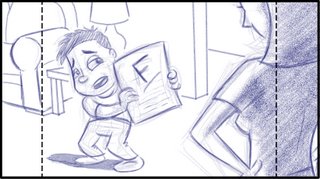Staging and Story pt 2
 Often I find that the point of the story is being lost simply by unclear staging. To the left is an example of a scene in which a boy is showing his mom he got an F on a paper at school. The boy is giving excuses at this point in the story and fearful of his mom's reaction. Though the staging is interesting the focus has been put on the mom. This is a great opportunity for some acting on the boy but it's missed and most likely will have a long paragraph worth of dialog assigned to this single panel. Many times I will see a panel like this with both the boy's and the mom's dialog set to it. No matter if you are creating the dialog or it's coming from a script, you need to look for opportunities for acting where you can give the audience a chance to know your character.
Often I find that the point of the story is being lost simply by unclear staging. To the left is an example of a scene in which a boy is showing his mom he got an F on a paper at school. The boy is giving excuses at this point in the story and fearful of his mom's reaction. Though the staging is interesting the focus has been put on the mom. This is a great opportunity for some acting on the boy but it's missed and most likely will have a long paragraph worth of dialog assigned to this single panel. Many times I will see a panel like this with both the boy's and the mom's dialog set to it. No matter if you are creating the dialog or it's coming from a script, you need to look for opportunities for acting where you can give the audience a chance to know your character. To the right is an alternate staging for the same scene. It gives the boy a chance to act and it's easy to tell right away what the scene is about. I would probably add several panels of acting in this same staging.
To the right is an alternate staging for the same scene. It gives the boy a chance to act and it's easy to tell right away what the scene is about. I would probably add several panels of acting in this same staging.Now you don't always have to be so blatant as this but it works. The best would be a combination of the two shots presented here. Start with the boy and cut to the mom's reaction. Even better would be to have the boy turn away from the mom in the shot where we see the mom. This could give him some good acting where he is making outlandish excuses that we know are lies. Then the mom could call him on it.
Some board artist also tend to misinterpret things like Over-The-Shoulder (OTS) shots, thinking in means the foreground character has their back to the camera and the character in the background is facing the camera. It really just means that one character is in the foreground(possibly partially cut off by the edge of the field) and the other in the background (or other action is in the background). Try to think of alternate ways to stage a scene so it's clear. Sometimes even simple straight on flat staging will make the scene clearer and actually more interesting. Especially if you've been doing more dynamic shots one after the other.


0 Comments:
Post a Comment
<< Home